The Indirect Role of Passive-Avoidant and Transformational Leadership through Job and Team Level Stressors on Workplace Cyberbullying
Abstract
1. Introduction
1.1. Conceptualization of WCB: Similarities and Differences Compared to Traditional WB
1.2. Work-Related Stress as Explanation for WCB
1.3. The Role of Leadership on a Stressful Work Environment
1.4. The Indirect Role of Destructive Leadership as Antecedent of WCB
1.4.1. Active Destructive Leadership Styles
1.4.2. Passive Destructive Leadership Styles
1.5. The Indirect Role of Constructive Leadership as Antecedent of WCB
1.6. Leadership—WCB Relationship in Germany and Spain
1.7. The Present Study
2. Materials and Methods
2.1. Study Design and Sampling
2.2. Participant Recruitment
2.3. German Sample Characteristics
2.4. Spanish Sample Characteristics
2.5. Measures
2.6. Statistical Analyses
3. Results
4. Discussion
4.1. The Cross-Cultural Perspective on the Leadership–WCB Relationship
4.2. Limitations and Future Research
4.3. Theoretical and Practical Implications
5. Conclusions
Author Contributions
Funding
Institutional Review Board Statement
Informed Consent Statement
Data Availability Statement
Conflicts of Interest
References
- Farley, S.; Coyne, I.; D’Cruz, P. Cyberbullying at Work: Understanding the Influence of Technology. In Concepts, Approaches and Methods; D’Cruz, P., Noronha, E., Notelaers, G., Rayner, C., Eds.; Handbooks of Workplace Bullying, Emotional Abuse and Harassment; Springer: Berlin, Germany, 2018; pp. 233–263. [Google Scholar] [CrossRef]
- De Stefano, V.; Durri, I.; Stylogiannis, C.; Wouters, M. System Needs Update Upgrading Protection against Cyberbullying and ICT-Enabled Violence and Harassment in the World of Work (No. 995060592502676); International Labour Organization: Geneva, Switzerland, 2020. [Google Scholar]
- European Working Conditions Survey 2015. Available online: https://www.eurofound.europa.eu/surveys/european-working-conditions-surveys/sixth-european-working-conditions-survey-2015 (accessed on 10 October 2022).
- Samnani, A.-K.; Singh, P. 20 years of workplace bullying research: A review of the antecedents and consequences of bullying in the workplace. Aggress. Violent Behav. 2012, 17, 581–589. [Google Scholar] [CrossRef]
- Hassard, J.; Teoh, K.; Visockaite, G.; Dewe, P.; Cox, T. The cost of work-related stress to society: A systematic review. J. Occup. Health Psychol. 2018, 23, 1–17. [Google Scholar] [CrossRef] [PubMed]
- D’Cruz, P.; Noronha, E. Navigating the extended reach: Target experiences of cyberbullying at work. Inf. Organ. 2013, 23, 324–343. [Google Scholar] [CrossRef]
- Czakert, J.P.; Armadans, I.; Pfaffinger, K.; Berger, R. The phenomenon of cyberbullying reaches the workplace: Prevalence and predictive factors [Poster presentation]. In Proceedings of the IV Congreso Internacional de la SCEPS y XV Congreso Nacional de Psicología Social, Virtual. 1–3 October 2020; Available online: https://sceps2020.siteonsite.es/poster/43 (accessed on 20 November 2022).
- Barlett, C.P.; Simmers, M.M.; Roth, B.; Gentile, D. Comparing cyberbullying prevalence and process before and during the COVID-19 pandemic. J. Soc. Psychol. 2021, 161, 408–418. [Google Scholar] [CrossRef]
- Coyne, I.; Farley, S.; Axtell, C.; Sprigg, C.; Best, L.; Kwok, O. Understanding the relationship between experiencing workplace cyberbullying, employee mental strain and job satisfaction: A dysempowerment approach. Int. J. Hum. Resour. 2017, 28, 945–972. [Google Scholar] [CrossRef]
- Tiamboonprasert, W.; Charoensukmongkol, P. Effect of Ethical Leadership on Workplace Cyberbullying Exposure and Organizational Commitment. Behav. Sci. 2020, 15, 85–100. Available online: https://so06.tci-thaijo.org/index.php/IJBS/article/view/243966 (accessed on 20 November 2022).
- Kowalski, R.M.; Giumetti, G.W.; Schroeder, A.N.; Lattanner, M.R. Bullying in the digital age: A critical review and meta-analysis of cyberbullying research among youth. Psychol. Bull. 2014, 140, 1073–1137. [Google Scholar] [CrossRef]
- Privitera, C.; Campbell, M.A. Cyberbullying: The new face of workplace bullying? Cyberpsychol. Behav. 2009, 12, 395–400. [Google Scholar] [CrossRef]
- Jenaro, C.; Flores, N.; Frías, C.P. Systematic review of empirical studies on cyberbullying in adults: What we know and what we should investigate. Aggress. Violent Behav. 2018, 38, 113–122. [Google Scholar] [CrossRef]
- Kowalski, R.M.; Toth, A.; Morgan, M. Bullying and cyberbullying in adulthood and the workplace. Soc. Psychol. 2018, 158, 64–81. [Google Scholar] [CrossRef]
- Forssell, R. Exploring cyberbullying and face-to-face bullying in working life—Prevalence, targets and expressions. Comput. Hum. Behav. 2016, 58, 454–460. [Google Scholar] [CrossRef]
- Gardner, D.; O’Driscoll, M.; Cooper-Thomas, H.D.; Roche, M.; Bentley, T.; Catley, B.; Teo, S.T.T.; Trenberth, L. Predictors of Workplace Bullying and Cyber-Bullying in New Zealand. Int. J. Environ. Res. Public Health 2016, 13, 448. [Google Scholar] [CrossRef] [PubMed]
- Vranjes, I.; Baillien, E.; Vandebosch, H.; Erreygers, S.; De Witte, H. When workplace bullying goes online: Construction and validation of the Inventory of Cyberbullying Acts at Work (ICA-W). Eur. J. Work Organ. Psychol. 2017, 27, 28–39. [Google Scholar] [CrossRef]
- Wang, B.; Liu, Y.; Parker, S.K. How Does the Use of Information Communication Technology Affect Individuals? A Work Design Perspective. Acad. Manag. Ann. 2020, 14, 695–725. [Google Scholar] [CrossRef]
- Van den Brande, W.; Baillien, E.; De Witte, H.; Vander Elst, T.; Godderis, L. The role of work stressors, coping strategies and coping resources in the process of workplace bullying: A systematic review and development of a comprehensive model. Aggress. Violent Behav. 2016, 29, 61–71. [Google Scholar] [CrossRef]
- Bowling, N.A.; Beehr, T.A. Workplace harassment from the victim’s perspective: A theoretical model and meta-analysis. J. Appl. Psychol. 2006, 91, 998–1012. [Google Scholar] [CrossRef]
- Baillien, E.; Bollen, K.; Euwema, M.; De Witte, H. Conflicts and conflict management styles as precursors of workplace bullying: A two-wave longitudinal study. Eur. J. Work Organ. Psychol. 2014, 23, 511–524. [Google Scholar] [CrossRef][Green Version]
- Hoel, H.; Glasø, L.; Hetland, J.; Cooper, C.; Einarsen, S. Leadership style as predictors of self reported and observed workplace bullying. Br. J. Manag. 2010, 21, 453–468. [Google Scholar] [CrossRef]
- Tsuno, K.; Kawakami, N. Multifactor leadership styles and new exposure to workplace bullying: A six-month prospective study. Ind. Health 2015, 53, 139–151. [Google Scholar] [CrossRef]
- Muhonen, T.; Jönsson, S.; Bäckström, M. Consequences of cyberbullying behaviour in working life: The mediating roles of social support and social organisational climate. Int. J. Workplace Health Manag. 2017, 10, 376–390. [Google Scholar] [CrossRef]
- Zhang, Z.; Wang, H.; Zhang, L.; Zheng, J. Workplace cyberbullying and interpersonal deviance: Roles of depletion and perceived supervisor support. Asia Pac. J. Hum. Resour. 2022, 60, 832–854. [Google Scholar] [CrossRef]
- Richard, E.M.; Walsh, J.J.; Zhou, Z.E. Cyberbullying in the workplace: Cross-cultural issues. In Cyberbullying in Schools, Workplaces, and Romantic Relationships: The Many Lenses and Perspectives of Electronic Mistreatment; Giumetti, G., Kowalski, R., Eds.; Taylor & Francis Ltd.: Oxfordshire, UK, 2019; pp. 98–117. [Google Scholar]
- Zwingmann, I.; Wegge, J.; Wolf, S.; Rudolf, M.; Schmidt, M.; Richter, P. Is transformational leadership healthy for employees? A multilevel analysis in 16 nations. Ger. J. Hum. Resour. Manag. 2014, 28, 24–51. [Google Scholar] [CrossRef]
- Einarsen, S.; Hoel, H.; Zapf, D.; Cooper, C.L. The concept of bullying and harassment at work: The European tradition. In Bullying and Harassment in the Workplace: Developments in Theory, Research, and Practice, 2nd ed.; Einarsen, S., Hoel, H., Zapf, D., Cooper, C., Eds.; CRC Press: Boca Raton, FL, USA, 2011; pp. 3–40. [Google Scholar]
- Vranjes, I.; Baillien, E.; Vandebosch, H.; Erreygers, S.; De Witte, H. The dark side of working online: Towards a definition and an Emotion Reaction model of workplace cyberbullying. Comput. Hum. Behav. 2017, 69, 324–334. [Google Scholar] [CrossRef]
- Walther, J.B. Theories of computer-mediated communication and interpersonal relations. In The SAGE Handbook of Interpersonal Communication, 4th ed.; Knapp, M., Daly, J., Eds.; SAGE Publications: Thousand Oaks, CA, USA, 2011; pp. 443–479. [Google Scholar]
- Friedman, R.A.; Currall, S.C. Conflict Escalation: Dispute Exacerbating Elements of E-mail Communication. Hum Relat. 2003, 56, 1325–1347. [Google Scholar] [CrossRef]
- Kruger, J.; Epley, N.; Parker, J.; Ng, Z.-W. Egocentrism over e-mail: Can we communicate as well as we think? J. Pers. Soc. Psychol. 2005, 89, 925–936. [Google Scholar] [CrossRef]
- Bailien, E.; De Cuyper, N.; De Witte, H. Job autonomy and workload as antecedents of workplace bullying: A two-wave test of Karasek’s Job Demand Control Model for targets and perpetrators. J. Occup. Organ. Psychol. 2011, 84, 191–208. [Google Scholar] [CrossRef]
- Hauge, L.J.; Skogstad, A.; Einarsen, S. Relationships between stressful work environments and bullying: Results of a large representative study. Work Stress 2007, 21, 220–242. [Google Scholar] [CrossRef]
- Leymann, H. The content and development of mobbing at work. Eur. J. Work Organ. Psychol. 1996, 5, 165–184. [Google Scholar] [CrossRef]
- Forssell, R. Gender and organisational position: Predicting victimisation of cyberbullying behaviour in working life. Int. J. Hum. Resour. 2020, 31, 2045–2064. [Google Scholar] [CrossRef]
- Salin, D. Ways of explaining workplace bullying: A review of enabling, motivating and precipitating structures and processes in the work environment. Hum. Relat. 2003, 56, 1213–1232. [Google Scholar] [CrossRef]
- Taris, T.W.; Schaufeli, W.B. The job demands-resources model. In The Wiley Blackwell Handbook of the Psychology of Occupational Safety and Workplace Health; Clarke, S., Probst, T., Guldenmund, T., Passmore, J., Eds.; Wiley Blackwell: Hoboken, NJ, USA, 2016; pp. 157–180. [Google Scholar]
- Fiedler, F. Time-based measures of leader experience and organizational performance: A review of research and a preliminary model. Leadersh. Q. 1992, 3, 5–23. [Google Scholar] [CrossRef]
- Kahn, R.; Wolfe, D.; Quinn, R.; Snoek, J.; Rosenthal, R. Organizational Stress: Studies in Role Conflict and Ambiguity; John Wiley: Hoboken, NJ, USA, 1964. [Google Scholar]
- Glazer, S.; Beehr, T.A. Consistency of implications of three role stressors across four countries. J. Organ. Behav. 2005, 26, 467–487. [Google Scholar] [CrossRef]
- Zahlquist, L.; Hetland, J.; Skogstad, A.; Bakker, A.B.; Einarsen, S.V. Job Demands as Risk Factors of Exposure to Bullying at Work: The Moderating Role of Team-Level Conflict Management Climate. Front. Psychol. 2019, 10, 2017. [Google Scholar] [CrossRef]
- Samnani, A.-K.; Singh, P. Workplace bullying: Considering the interaction between individual and work environment. J. Bus. Ethics 2016, 139, 537–549. [Google Scholar] [CrossRef]
- Elias, R. The Politics of Victimization: Victims, Victimology, and Human Rights; Oxford University Press: Oxford, UK, 1986. [Google Scholar]
- Czakert, J.P.; Reif, J.; Glazer, S.; Berger, R. Adaptation and Psychometric Cross-Cultural Validation of a Workplace Cyberbullying Questionnaire in Spain and Germany. Cyberpsychol. Behav. Soc. Netw. 2021, 24, 831–838. [Google Scholar] [CrossRef]
- Thayer, A.L.; Petruzzelli, A.; McClurg, C.E. Addressing the paradox of the team innovation process: A review and practical considerations. Am. Psychol. 2018, 73, 363–375. [Google Scholar] [CrossRef]
- West, B.; Foster, M.; Levin, A.; Edmison, J.; Robibero, D. Cyberbullying at work: In search of effective guidance. Laws 2014, 3, 598–617. [Google Scholar] [CrossRef]
- Farley, S.; Coyne, I.; Sprigg, C.; Axtell, C.; Subramanian, G. Exploring the impact of workplace cyberbullying on trainee doctors. Med. Educ. 2015, 49, 436–443. [Google Scholar] [CrossRef]
- Ayoko, O.B.; Callan, V.J.; Härtel, C.E.J. Workplace Conflict, Bullying and Counterproductive Behaviors. Int. J. Organ. Anal. 2003, 11, 283–301. [Google Scholar] [CrossRef]
- Schaufeli, W.B. Engaging leadership in the job demands-resources model. Career Dev. Int. 2015, 20, 446–463. [Google Scholar] [CrossRef]
- Berger, R.; Czakert, J.P.; Leuteritz, J.-P.; Leiva, D. How and When Do Leaders Influence Employees’ Well-Being? Moderated Mediation Models for Job Demands and Resources. Front. Psychol. 2019, 10, 2788. [Google Scholar] [CrossRef] [PubMed]
- Oc, B. Contextual leadership: A systematic review of how contextual factors shape leadership and its outcomes. Leadersh. Q. 2018, 29, 218–235. [Google Scholar] [CrossRef]
- Katz, D.; Kahn, R. The Social Psychology of Organizations; John Wiley: Hoboken, NJ, USA, 1978. [Google Scholar]
- Samnani, A.-K. The Role and Impact of Leaders on Workplace Bullying, Emotional Abuse and Harassment BT. In Pathways of Job-Related Negative Behaviour; D’Cruz, P., Noronha, E., Baillien, E., Catley, B., Harlos, K., Høgh, A., Mikkelsen, E., Eds.; Springer: Singapore, 2021; pp. 361–383. [Google Scholar] [CrossRef]
- Harms, P.D.; Credé, M.; Tynan, M.; Leon, M.; Jeung, W. Leadership and stress: A meta-analytic review. Leadersh. Q. 2017, 28, 178–194. [Google Scholar] [CrossRef]
- Hetland, H.; Skogstad, A.; Hetland, J.; Mikkelsen, A. Leadership and learning climate in a work setting. Eur. Psychol. 2011, 16, 163–173. [Google Scholar] [CrossRef]
- Woodrow, C.; Guest, D. Leadership and approaches to the management of workplace bullying. Eur. J. Work Organ. Psychol. 2017, 26, 221–233. [Google Scholar] [CrossRef]
- Astrauskaite, M.; Notelaers, G.; Medisauskaite, A.; Kern, R. Workplace harassment: Deterring role of transformational leadership and core job characteristics. Scand. J. Manag. 2015, 31, 121–135. [Google Scholar] [CrossRef]
- Hauge, L.; Einarsen, S.; Knardahl, S.; Lau, B.; Notelaers, G.; Skogstad, A. Leadership and Role Stressors as Departmental Level Predictors of Workplace Bullying. Int. J. Stress Manag. 2011, 18, 305–323. [Google Scholar] [CrossRef]
- Zapf, D.; Escartín, J.; Einarsen, S.; Hoel, H.; Vartia, M. Empirical findings on prevalence and risk groups of bullying in the workplace. In Workplace Bullying: Developments in Theory, Research and Practice; Einarsen, S., Hoel, H., Zapf, D., Cooper, C., Eds.; Taylor & Francis: Oxfordshire, UK, 2011; pp. 75–105. [Google Scholar]
- Agotnes, K.; Einarsen, S.; Hetland, J.; Skogstad, A. The moderating effect of laissez-faire leadership on the relationship between co-worker conflicts and new cases of workplace bullying: A true prospective design. Hum. Resour. Manag. J. 2018, 28, 555–568. [Google Scholar] [CrossRef]
- Molero Alonso, F.; Saboya, P.; Cuadrado Guirado, I. Transformational and transactional leadership: An analysis of the factor structure of the multifactor leadership questionnaire (MLQ) in a spanish sample. Psicothema 2010, 22, 495–501. [Google Scholar]
- Bass, B. Leadership and Performance Beyond Expectations; Free Press: New York, NY, USA, 1985. [Google Scholar]
- Barling, J.; Frone, M.R. If only my leader would just do something! Passive leadership undermines employee well−being through role stressors and psychological resource depletion. Stress Health 2017, 33, 211–222. [Google Scholar] [CrossRef]
- Skogstad, A.; Einarsen, S.; Torsheim, T.; Aasland, M.S.; Hetland, H. The destructiveness of laissez-faire leadership behavior. J. Occup. Health Psychol. 2007, 12, 80–92. [Google Scholar] [CrossRef] [PubMed]
- Bass, B.; Riggio, R. Transformational Leadership, 2nd ed.; Lawrence Erlbaum Associates Publishers: Mahwah, NJ, USA, 2006. [Google Scholar]
- Ayoko, O.B.; Callan, V.J. Teams’ reactions to conflict and teams’ task and social outcomes: The moderating role of transformational and emotional leadership. Eur. Manag. J. 2010, 28, 220–235. [Google Scholar] [CrossRef]
- Popper, M.; Mayseless, O. Back to basics: Applying a parenting perspective to transformational leadership. Leadersh. Q. 2003, 14, 41–65. [Google Scholar] [CrossRef]
- Stouten, J.; van Dijke, M.; De Cremer, D. Ethical leadership: An overview and future perspectives. J. Pers. Psychol. 2012, 11, 1–6. [Google Scholar] [CrossRef]
- Hoch, J.E.; Bommer, W.H.; Dulebohn, J.H.; Wu, D. Do ethical, authentic, and servant leadership explain variance above and beyond transformational leadership? A meta-analysis. J. Manag. 2018, 44, 501–529. [Google Scholar] [CrossRef]
- Decuypere, A.; Schaufeli, W. Leadership and work engagement: Exploring explanatory mechanisms. Ger. J. Hum. Resour. Manag. 2020, 34, 69–95. [Google Scholar] [CrossRef]
- Telework and ICT-Based Mobile Work: Flexible Working in the Digital Age. New Forms of Employment Series. Publications Office of the European Union. Available online: https://www.eurofound.europa.eu/publications/report/2020/telework-and-ict-based-mobile-work-flexible-working-in-the-digital-age (accessed on 10 October 2022).
- Javidan, M.; Dastmalchian, A. Managerial implications of the GLOBE project: A study of 62 societies. Asia Pac. J. Hum. Resour. 2009, 47, 41–58. [Google Scholar] [CrossRef]
- Ethical Principles of Psychologists and Code of Conduct. Available online: https://www.apa.org/ethics/code (accessed on 31 October 2020).
- World Medical Association. World Medical Association Declaration of Helsinki ethical principles for medical research involving human subjects. JAMA 2013, 310, 2191–2194. [Google Scholar] [CrossRef]
- International Test Commission. The ITC Guidelines for Translating and Adapting Tests, 2nd ed.; ITC: Hemel Hempstead, UK, 2017. [Google Scholar]
- Jönsson, S.; Muhonen, T.; Forssell, R.; Bäckström, M. Assessing Exposure to Bullying through Digital Devices in Working Life: Two Versions of a Cyberbullying Questionnaire (CBQ). J. Psychol. 2017, 8, 477–494. [Google Scholar] [CrossRef]
- Vagg, P.R.; Spielberger, C.D. Occupational stress: Measuring job pressure and organizational support in the workplace. J. Occup. Health Psychol. 1998, 3, 294–305. [Google Scholar] [CrossRef]
- Avolio, B.; Bass, B. Multifactor Leadership Questionnaire: Manual and Sampler Set, 3rd ed.; Mindgarden: Redwood City, CA, USA, 2004. [Google Scholar]
- Berger, R.; Romeo, M.; Guardia, J.; Yepes, M.; Soria, M.A. Psychometric properties of the spanish human system audit short-scale of transformational leadership. Span. J. Psychol. 2012, 15, 367–375. [Google Scholar] [CrossRef] [PubMed]
- Berger, R.; Antonioli, T.C. Psychometric properties of the human system audit-transformational leadership short scale in Germany and Philippines: A cross-cultural study. Psychologica 2019, 62, 165–185. [Google Scholar] [CrossRef] [PubMed]
- Quijano, S.; Navarro, J.; Yepes-Baldó, M.; Berger, R.; Romeo, M. Human System Audit (HSA) for the analysis of human behaviour in organisations. Pap. Psicol. 2008, 29, 92–106. [Google Scholar]
- Tehseen, S.; Ramayah, T.; Sajilan, S. Testing and Controlling for Common Method Variance: A Review of Available Methods. J. Manag. Sci. 2017, 4, 142–168. [Google Scholar] [CrossRef]
- Hayes, A. Introduction to Mediation, Moderation, and Conditional Process Analysis Second Edition: A Regression-Based Approach; Guilford Press: New York, NY, USA, 2018. [Google Scholar]
- Doty, D.H.; Glick, W.H. Common methods bias: Does common methods variance really bias results? Organ. Res. Methods 1998, 1, 374–406. [Google Scholar] [CrossRef]
- Banks, G.C.; Woznyj, H.M.; Mansfield, C.A. Where is “behavior” in organizational behavior? A call for a revolution in leadership research and beyond. Leadersh. Q. 2021, 101581. [Google Scholar] [CrossRef]
- Efron, B. Bootstrap methods: Another look at the jackknife. Ann. Stat. 1979, 7, 1–26. [Google Scholar] [CrossRef]

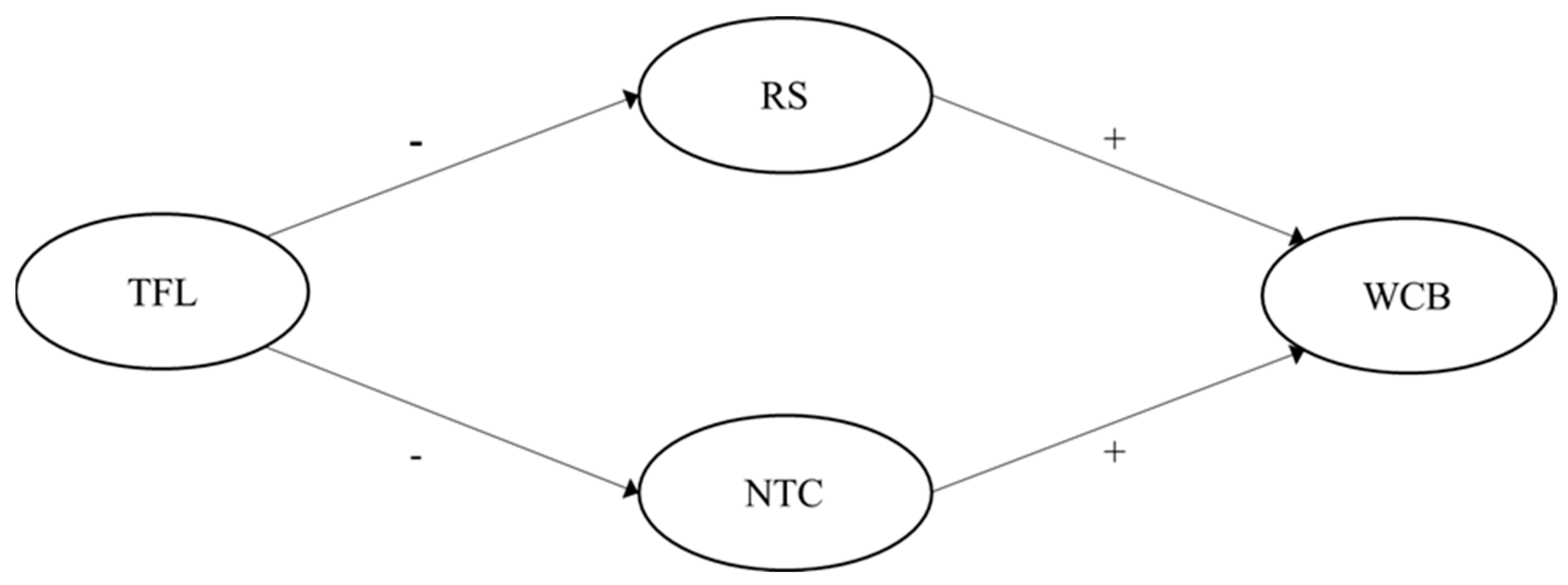
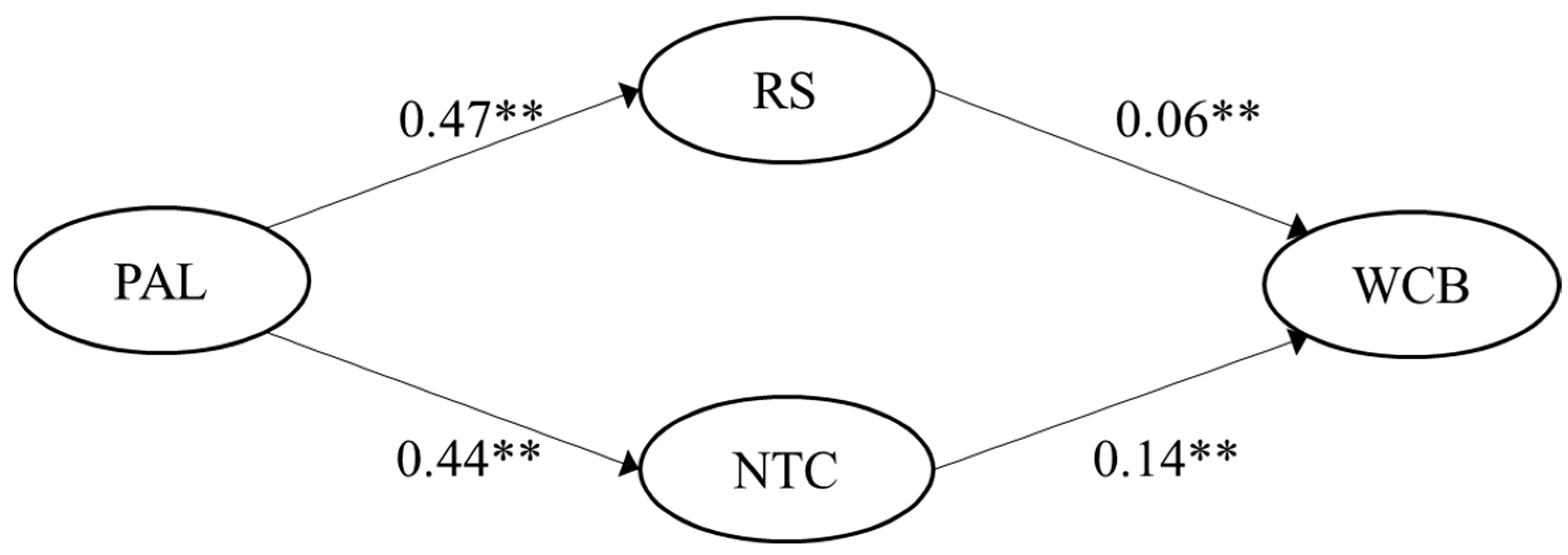
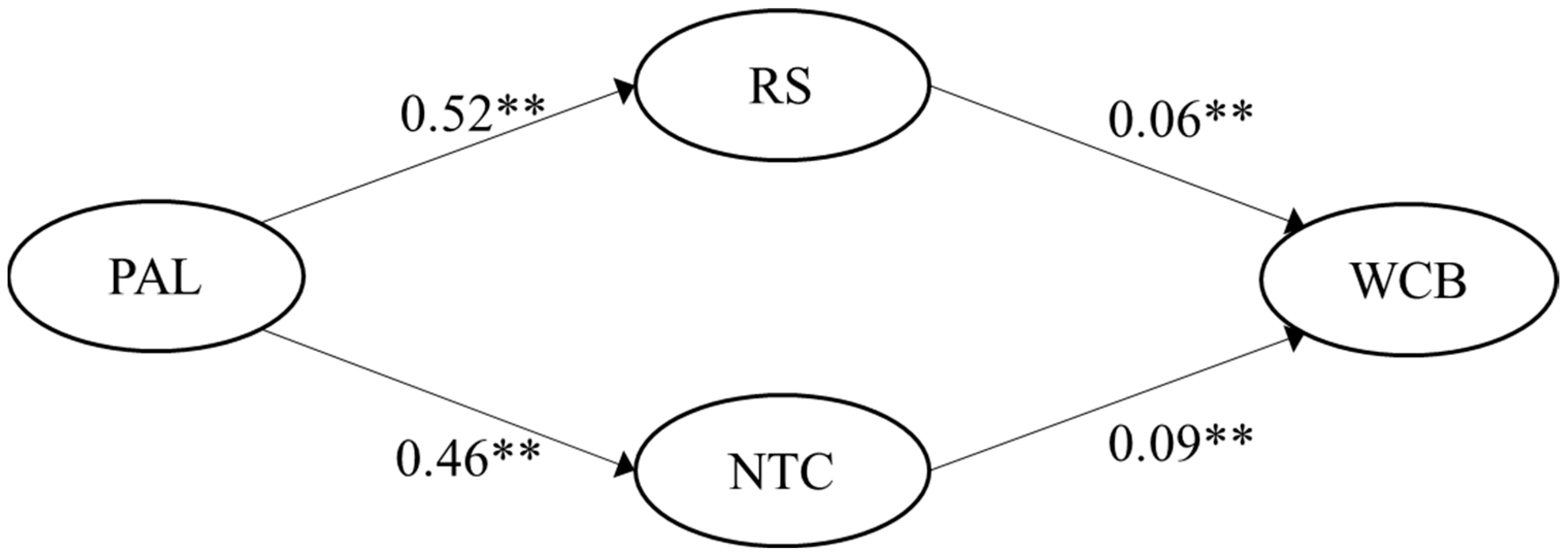
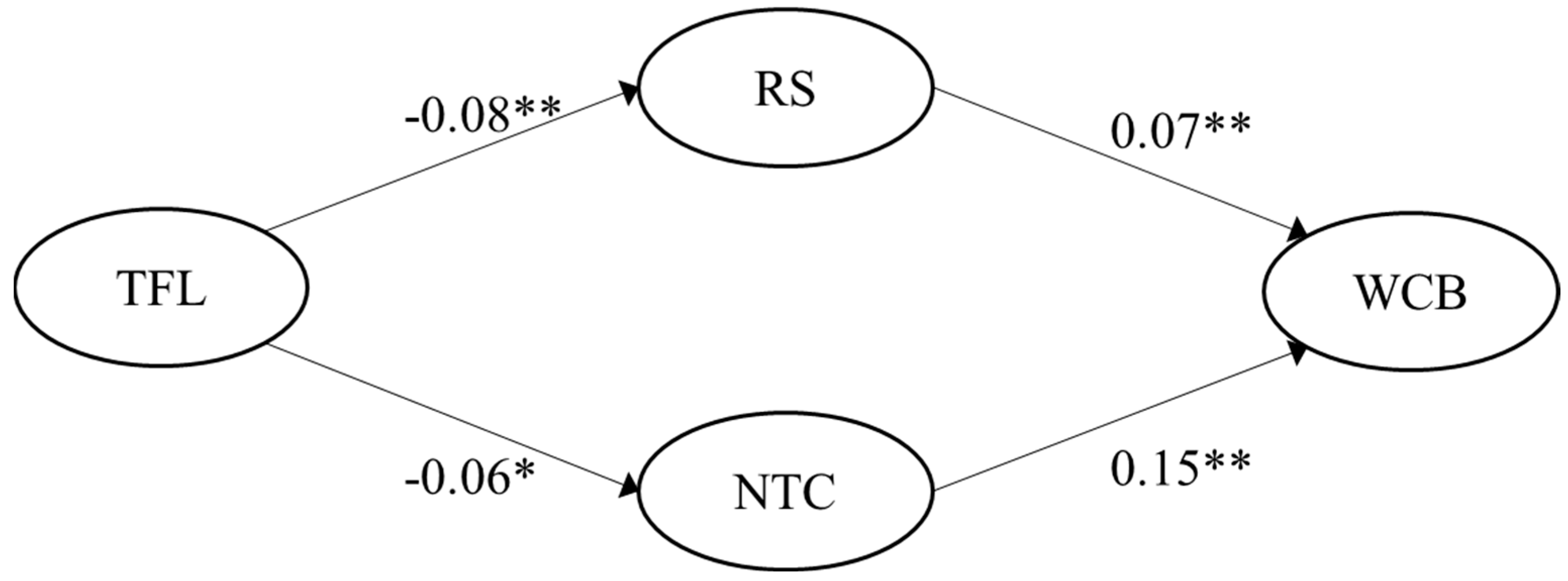
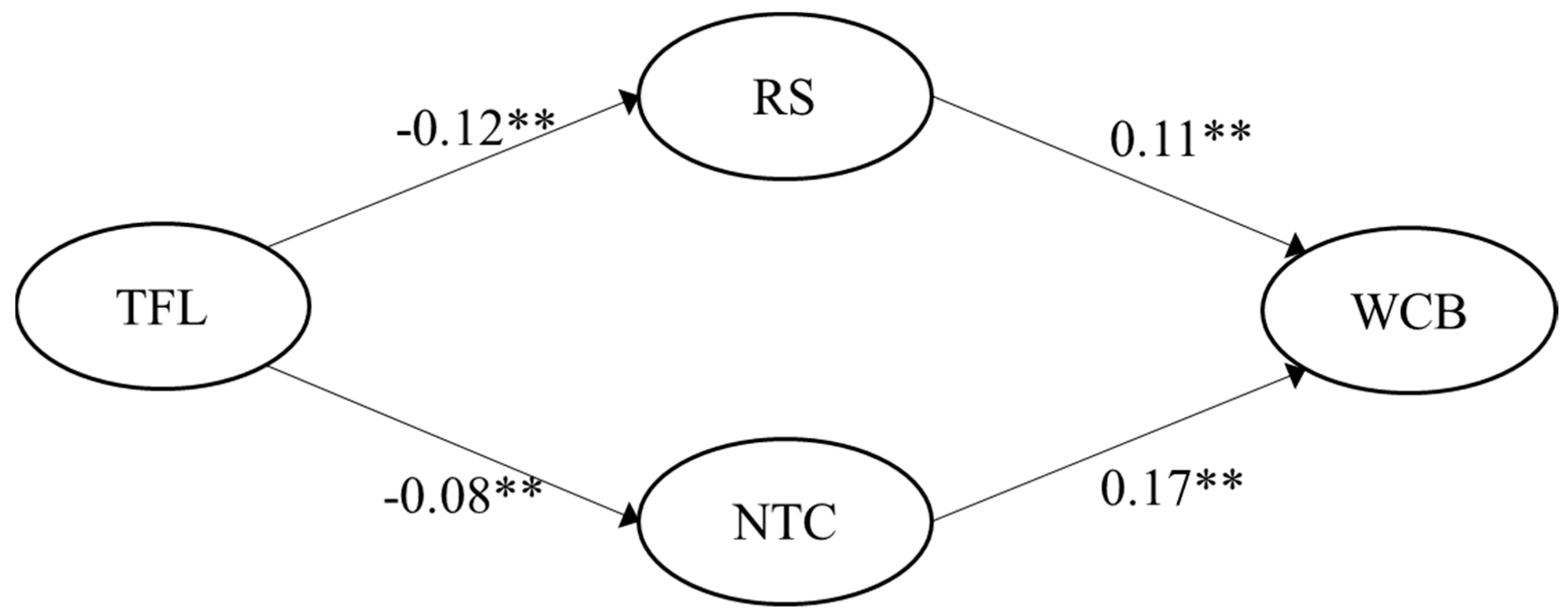
| Measure | M | SD | TFL | PAL | RS | NTC | WCB |
|---|---|---|---|---|---|---|---|
| TFL | 24.65 | 8.81 | 1 | −0.33 ** | −0.23 ** | −0.20 ** | −0.11 |
| PAL | 9.80 | 5.06 | −0.40 ** | 1 | 0.65 ** | 0.70 ** | 0.72 ** |
| RS | 4.71 | 2.17 | −0.17 ** | 0.57 ** | 1 | 0.54 ** | 0.65 ** |
| NTC | 7.47 | 3.32 | −0.16 ** | 0.67 ** | 0.57 ** | 1 | 0.72 ** |
| WCB | 10.45 † | 6.35 † | 0.05 | 0.41 ** | 0.44 ** | 0.53 ** | 1 |
Publisher’s Note: MDPI stays neutral with regard to jurisdictional claims in published maps and institutional affiliations. |
© 2022 by the authors. Licensee MDPI, Basel, Switzerland. This article is an open access article distributed under the terms and conditions of the Creative Commons Attribution (CC BY) license (https://creativecommons.org/licenses/by/4.0/).
Share and Cite
Czakert, J.P.; Berger, R. The Indirect Role of Passive-Avoidant and Transformational Leadership through Job and Team Level Stressors on Workplace Cyberbullying. Int. J. Environ. Res. Public Health 2022, 19, 15984. https://doi.org/10.3390/ijerph192315984
Czakert JP, Berger R. The Indirect Role of Passive-Avoidant and Transformational Leadership through Job and Team Level Stressors on Workplace Cyberbullying. International Journal of Environmental Research and Public Health. 2022; 19(23):15984. https://doi.org/10.3390/ijerph192315984
Chicago/Turabian StyleCzakert, Jan Philipp, and Rita Berger. 2022. "The Indirect Role of Passive-Avoidant and Transformational Leadership through Job and Team Level Stressors on Workplace Cyberbullying" International Journal of Environmental Research and Public Health 19, no. 23: 15984. https://doi.org/10.3390/ijerph192315984
APA StyleCzakert, J. P., & Berger, R. (2022). The Indirect Role of Passive-Avoidant and Transformational Leadership through Job and Team Level Stressors on Workplace Cyberbullying. International Journal of Environmental Research and Public Health, 19(23), 15984. https://doi.org/10.3390/ijerph192315984








